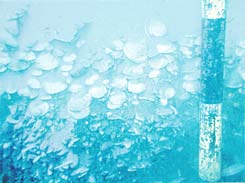Marine explorers: A huge wave washed over Caesarea at the beginning of the second century

The shell layer near Caesarea that testified to the impact of the tsunami.
Photo: Prof. Edward Reinhart
What shook the breakwater of the city of Caesarea at the beginning of the second century AD, and caused severe damage to one of the most important ports of the eastern Mediterranean at that time? Archaeologists and geologists have wrestled with this question, and now they believe that it is a tsunami wave that came from an unknown earthquake center in the Mediterranean Sea. Late last year, a tsunami in Southeast Asia caused the worst natural disaster in recorded history.
The Haifa port area has been studied for years by archaeologists and marine geologists, led by the late Prof. Avner Raban, who studied, among other things, heavy damage caused to the port of Caesarea at the beginning of the second century AD. About two years ago, one of the research expeditions carried out an excavation in the sea, west of the sunken breakwater of the old city, and reached a find that piqued their curiosity. A layer of silt containing large shell fragments was found in the water, and it was not clear how it was formed. The fragments of the shells were sent for examination, and it turned out that they had reached the sea around
The area of impact according to the team of investigators. from here
The date is 100 AD.
This year, with the support of the "Eco-Ocean" association from Tel Aviv, another delegation led by Prof. Edward Reinhart from Canada and Prof. Yossi Mert from Haifa University went to Caesarea. This time the excavators decided to drill into the seabed, to try and understand the reasons for the stacking of shell fragments. The drillings were conducted at depths of 20-15 meters, and a layer of coarse silt containing large fragments of shells was found in them.
"Such a layer on the bottom of the sea cannot be created by a normal wave, because it lacks the energy needed to invest in seashells of this size," says Prof. Mert. "Therefore, there is a possibility that this is a large flood from a stream coming from the direction of the land, or a returning wave of a tsunami that brought the oysters with it from the shore. Since there is no stream in the area that can create such a flood, we believe that it is a tsunami that occurred around 100 AD."
According to Mert, there is evidence that in 115 AD an earthquake occurred in the Mediterranean Sea, creating a tsunami wave that destroyed the city of Antioch and damaged the cities of Caesarea and Yavne. It is also known that the breakwater of Caesarea and buildings in the port were indeed badly damaged at that time.
The city of Caesarea was one of the largest and most important Roman cities in the eastern Mediterranean. It was founded by King Herod in the first century BC, and was destroyed by the Muslims in the 13th century after they conquered it from the Crusaders. The port established by King Herod in the city is considered one of the most sophisticated in the ancient world. It included an external anchorage with a breakwater, and many warehouses.
According to some geologists, evidence of tsunami waves in the eastern Mediterranean region also exists from later periods. In 1034, a strong earthquake occurred in the Mediterranean Sea, and the city of Acre was apparently damaged by a tsunami wave created by this earthquake. The tsunami also hit the city of Jaffa.
This November, the researchers intend to return to Caesarea and find more evidence that it was indeed a tsunami that hit the ancient city. Following the findings of the latest study in Caesarea, Prof. Mert pointed out that since tsunami waves have occurred in the past, it is likely that they will also occur in the future, and then they may damage facilities such as the power plant located south of Caesarea. "We need to arrive at certain proofs that it is indeed a tsunami, and then check how facilities on the coast can be protected with the help of proper engineering planning," Mart pointed out.
